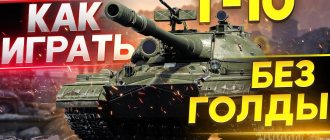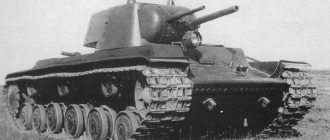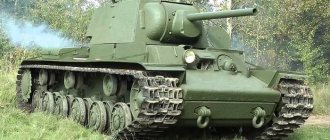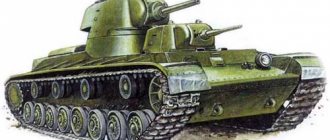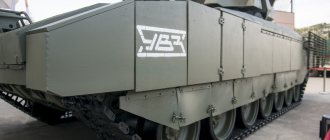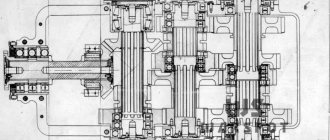The KV-2 heavy tank (Klim Voroshilov) was designed at SKB-2 LKZ (Leningrad) under the leadership of Zh.Ya. Kotin (leading engineer L.N. Dukhov) in 1939-1940. The first prototype of the tank, designated No. U-1, was manufactured at LKZ in early February 1940. During serial production at LKZ (Leningrad) in 1940-1941, 204 KV-2 tanks were manufactured.
Tank KV-2 Engine. Weight. Dimensions. Armament
What is the KV-2 - a Soviet heavy assault tank from the initial period of the Great Patriotic War. The abbreviation KV means “Kliment Voroshilov” - the official name of the serial Soviet heavy tanks produced in 1939-1943, named in honor of the hero of the Civil War in Russia, military and political figure Kliment Efremovich Voroshilov. Initially it was called “KV with a large tower”.
Tank KV-2 - video
This vehicle was developed by the design bureau of the Leningrad Kirov Plant (LKZ) in January 1940 in connection with the urgent need of the Workers 'and Peasants' Red Army (RKKA) for a well-protected tank with powerful weapons to combat the fortifications of the Mannerheim Line during the Soviet-Finnish War of 1939— 1940s
Design
The armored body of the tank was welded from rolled armor plates with a thickness of 75, 40, 30 and 20 mm. The armor protection is equally strong (armor plates with a thickness other than 75 mm were used only for horizontal armoring of the vehicle), and is projectile-resistant. The armor plates of the frontal part of the vehicle were installed at rational angles of inclination. At the same time, the first samples of KV-2 tanks differed from production vehicles in the shape of the turret and the configuration of the gun mantlet. The production KV-2 turret was produced in two versions: the initial MT-1 mount and a later “lowered” turret of lesser mass. Externally, these two types of towers are easily distinguishable by their frontal ends: the MT-1 installation has inclined zygomatic armor plates, and the “lowered” version has vertical ones. Both versions of the towers were welded from rolled armor plates, their armor thickness was 75 mm. The “lowered” modification of the turret had a ball mount for a DT machine gun next to its rear door. The turret was mounted on a shoulder strap with a diameter of 1535 mm in the armored roof of the fighting compartment and was secured with grips to prevent stalling in case of a strong roll or overturning of the tank. The goniometer circle of the tower was marked in thousandths for firing from closed positions.
The driver was located in the center in the front part of the armored hull of the tank, to the left of him was the radio operator's workplace. Four crew members were located in the turret: to the left of the gun were the positions of the gunner and loader, and to the right were the tank commander and assistant loader. The crew entered and exited through the rear door of the turret and two round hatches: one in the turret in the commander’s position and one in the hull in the radio operator’s position. The hull also had a bottom hatch for emergency escape by the crew of the tank and a number of hatches, hatches and technological openings for loading ammunition, access to the necks of fuel tanks, and other components and assemblies of the vehicle.
Engine
The KV-2 was equipped with a four-stroke V-shaped 12-cylinder diesel engine V-2K with a power of 500 hp. With. (382 kW) at 1800 rpm, subsequently the engine power was increased to 600 hp. With. (441 kW). Starting the engine was ensured by an ST-700 starter with a power of 15 hp. With. (11 kW) or compressed air from two 5-liter tanks in the fighting compartment of the vehicle. The KV-2 had a dense layout, in which the main fuel tanks with a volume of 600-615 liters were located in both the combat and engine compartments.
Transmission
The KV-2 tank was equipped with a mechanical transmission, which included:
— multi-disc main clutch of dry friction “steel on ferodo”; — five-speed tractor-type gearbox; — two multi-disc onboard clutches with “steel on steel” friction; — two onboard planetary gearboxes. — band floating brakes
All transmission control drives are mechanical. When used by the troops, the greatest number of complaints and complaints to the manufacturer were caused by defects and extremely unreliable operation of the transmission group, especially in overloaded wartime KV tanks. Almost all authoritative printed sources recognize that one of the most significant shortcomings of the KV series tanks and vehicles based on it is the low overall reliability of the transmission as a whole.
Chassis
The vehicle's suspension is individual torsion bar with internal shock absorption for each of the 6 small-diameter gable road wheels on each side. Opposite each road wheel, travel limiters of the suspension balancers were welded to the armored body. The drive wheels with removable pinion gears were located at the rear, and the idlers were located at the front. The upper branch of the caterpillar was supported by three small rubber-coated support rollers on each side. The caterpillar tension mechanism is screw; each caterpillar consisted of 86-90 single-ridge tracks with a width of 700 mm and a pitch of 160 mm.
Electrical equipment
The electrical wiring in the KV-2 tank was single-wire, the second wire being the armored hull of the vehicle. The exception was the emergency lighting circuit, which was two-wire. The sources of electricity (operating voltage 24 V) were a GT-4563A generator with a RPA-24 relay-regulator with a power of 1 kW and four series-connected 6-STE-128 batteries. Electricity consumers included:
— electric motor for turning the tower; — external and internal lighting of the vehicle, illumination devices for sights and scales of measuring instruments; — external sound signal and alarm circuit from the landing force to the vehicle crew; — instrumentation (ammeter and voltmeter); - communication means - radio station and tank intercom; - electrician of the motor group - ST-700 starter, RS-371 or RS-400 starting relay, etc.
Surveillance equipment and sights
The general visibility of the KV-2 tank back in 1940 was assessed in a memo to L. Mehlis from military engineer Kalivoda as extremely unsatisfactory. The vehicle commander had the only viewing device in the turret - the PTK panorama. In combat, the driver conducted observation through a viewing device with a triplex, which was protected by an armored flap. This viewing device was installed in an armored hatch on the front armor plate along the longitudinal center line of the vehicle. In a quiet environment, this plug hatch could be pulled forward, providing the driver with a more convenient direct view from his workplace.
For firing, the KV-2 was equipped with two gun sights - the telescopic TOD-9 for direct fire and the periscopic PT-9 for firing from closed positions. The head of the periscope sight was protected by a special armored cap. To ensure the possibility of fire in the dark, the sight scales had illumination devices. The forward and stern DT machine guns could be equipped with a PU sight from a sniper rifle with a threefold magnification.
Means of communication
Communication equipment included a shortwave radio station 71-TK-3 and an internal intercom TPU-4-Bis for 4 subscribers. All produced KV-2 tanks were equipped with radio stations.
The TPU-4-Bis tank intercom made it possible to negotiate between members of the tank crew even in a very noisy environment and connect a headset (headphones and laryngophones) to a radio station for external communication.
Armament
The KV-2 tank was equipped with a 152-mm tank howitzer mod. 1938/40 (M-10T), a tank version of the 1938 model field howitzer (M-10). The M-10T howitzer was mounted on axles in the turret and was completely balanced, but the turret with the M-10T gun was not balanced: its center of mass was not located on the geometric axis of rotation. As a result, the standard electric motor for driving the turret rotation could not cope with its task even with a slight roll of the vehicle. The M-10T howitzer had vertical aiming angles from −3 to +18°; with a fixed turret position, it could be aimed in a small sector of horizontal aiming (the so-called “jewelry” aiming). The shot was fired using a manual mechanical trigger.
The gun's ammunition capacity was 36 rounds of separate loading. The shots (shells and propellant charges in cartridges) were placed in the turret and along both sides of the fighting compartment. Compared to the wide range of ammunition of the 152 mm M-10 howitzer, the standard ammunition of the KV-2 was limited to only one type of ammunition:
- high-explosive fragmentation steel howitzer grenade OF-530 weighing 40 kg (mass of explosive - TNT or ammotol - from 5.47 to 6.86 kg) and a special charge obtained from the standard Zh-536 charge of the M-10 towed howitzer by removing several equilibrium gunpowder beams.
However, in practice, in the chaos of the summer of 1941, due to the desperate situation with the supply of the KV-2 with the ammunition required by the state, any type of 152-mm howitzer shells suitable for the M-10 howitzer that could be found was used (in some military districts the supply was at the level of 10%, in other standard ammunition for the KV-2 there was no ammunition at all). That is, both G-530 concrete-piercing shells and O-530A steel cast iron fragmentation howitzer grenades, incendiary shells, old high-explosive grenades, and shrapnel could be used. Firing at full charge was strictly prohibited, since due to the high recoil and rollback, the turret could jam, and the components and assemblies of the engine-transmission group could be damaged by the shock. For the latter reason, shooting was only allowed from a standing position, which further increased the tank's vulnerability in battle. The armor penetration of M-10T tank howitzer shells is not given in available sources, but in practice it was capable of penetrating the armor of any Wehrmacht armored vehicle in 1941 and early 1942. Armor penetration of a naval semi-armor-piercing projectile mod. 1915/28 was 72 mm of steel from a distance of 1500 meters at an angle of 60 degrees.
Soviet heavy tank KV-2 (serial number B-9633) on display to the command staff of the Red Army at the training ground in Kubinka near Moscow. The vehicle was captured before overcoming an anti-tank ditch.
The production KV-2 tank was equipped with three 7.62-mm DT machine guns: a coaxial one with a gun, as well as a forward and aft one in ball mounts. The ammunition load for all diesel engines was 3087 rounds. These machine guns were mounted in such a way that, if necessary, they could be removed from the mounts and used outside the tank. Also, for self-defense, the crew had several F-1 hand grenades and was sometimes equipped with a pistol for firing flares.
In the initial period of the war, the KV-2 easily destroyed any enemy tank, and almost always with impunity, since its armor was not penetrated by shells from tank guns or standard anti-tank artillery. Only Flak 18/36/37 anti-aircraft guns, which were not originally intended for this purpose, could effectively combat the KV-2.
Production
In February 1940, the KV-2 was officially adopted by the Red Army and was mass-produced at LKZ until July 1941. The reason for discontinuation was the outbreak of the Great Patriotic War. In total, LKZ built 204 KV-2 tanks, which were actively used in combat operations in 1941 and then almost all were lost.
Combat use
Factory tests of the new tank did not last long. Already on February 17, both prototypes went to the front. During military tests, the information necessary for improvements was collected. In particular, the range of acceptable ammunition was expanded - it was the fortifications of the Mannerheim Line that became the objects thanks to which the “tank with a big turret” began to fire concrete-piercing shells. The military also made a number of proposals regarding the layout of the new tower. In accordance with these recommendations, in the second half of 1940, SKB-2 engineers finalized its shape. First of all, its dimensions were altered. The updated tank turret had a lower height and was designated MT-2. At the same time, the shape of the frontal and side plates was changed. For ease of assembly, the forehead of the turret became rectangular, and not trapezoidal, as before. The gun mantlet was also redesigned and several smaller improvements were introduced.
The modified tank with the MT-2 turret was what the military wanted. Now the armament of the armored vehicle had the proper power and ease of use. As for the level of protection, the armor of KV tanks received the most flattering reviews from the very beginning of their combat work. So, after the battles, there were dozens of dents from enemy shells on the forehead, sides and turrets of experienced “tanks with a large turret”. Over several months of combat testing, not one of them was able to penetrate 75 millimeters of rolled homogeneous armor. As an example of the power of the weapons and the level of protection of the new vehicle, we can cite the words of tanker E. F. Glushak:
— The obstacles on the Mannerheim Line were made thoroughly. In front of us, huge granite pillars rose in three rows. And yet, in order to make a passage 6-8 meters wide, we only needed five shots of concrete-piercing shells. While we were breaking into the holes, the enemy was continuously firing at us. We quickly spotted the pillbox, and then completely destroyed it with two shots. When we left the battle, there were 48 dents on the armor, but not a single hole.
German soldiers near a Soviet KV-2 heavy tank with an MT-1 turret, knocked out near the Lithuanian town of Shaukotas, 30 kilometers from Raseiniai. A vehicle produced in July–August 1940 from the 2nd Tank Division of the 3rd Mechanized Corps of the 11th Army of the Northwestern Front. Numerous marks from hits from 37 mm armor-piercing shells are visible on the turret.
The combination of protection, weapons and mobility influenced the decision of the People's Commissariat of Defense. At the beginning of 1941, the new tank was put into service under the designation KV-2. Serial production was launched at the Leningrad Kirov plant. The KV-2 was produced until October 1941. In the first months of the war, the production of heavy tanks gradually decreased. The reason for this was several factors: the complexity and labor intensity of production, the difficult situation of industry, the need to evacuate production, etc. The exact number of KV-2 tanks produced raises questions. The most often cited figure is 330-340 cars. However, a number of sources indicate the fact that Perm plant No. 172 managed to produce only a hundred suspension systems for howitzers. From this a conclusion is drawn about the corresponding number of assembled tanks.
Despite the relatively small number of KV-2 tanks produced, they created a real sensation on the fronts of the Great Patriotic War. With their 152-mm shells, heavy tanks confidently hit all German armored vehicles available at that time. The armor, in turn, was enough to protect against the vast majority of guns. Only 88-mm anti-aircraft guns could more or less normally fight the Klim Voroshilovs of the second model. However, the duel between the tank and anti-aircraft gunners did not have a clear result in advance: due to its larger caliber, the tank could destroy the gun crew without entering the guaranteed destruction zone. In addition, the tankers were located behind full armor plates, and not behind the gun’s bulletproof shield. Overall, the KV-1 and KV-2 were a formidable force to be feared. However, some nuances of application, logistics, etc. led to sad results.
The 4th Panzer Division is often cited as an example of the failures of new tanks. During the first two weeks of the Great Patriotic War, this formation lost 22 KV-2 tanks. However, only five of them were shot down by the enemy. The rest were abandoned or destroyed by the crew due to lack of fuel or spare parts. As a matter of fact, the bulk of the losses of Soviet heavy tanks occurred in non-combat incidents. Supply difficulties and constant retreats forced tankers not to repair their vehicles, but to abandon or destroy them. Nevertheless, even in such difficult conditions, Soviet tankers caused a lot of problems for the enemy. A striking example of this is the memoirs of one of the German officers who served in the 1st Panzer Division:
“Our companies opened fire from 700 m. We were getting closer. Soon we were already 50-100 m from each other. But we couldn't succeed. Soviet tanks continued to advance, and our armor-piercing shells simply bounced off their armor. The tanks withstood direct fire from 50 mm and 75 mm guns. The KV-2 was hit by more than 70 shells, but not one was able to penetrate its armor. Several tanks were disabled when we managed to hit the tracks and then shoot them from a short distance with cannons. They were then attacked by sappers with backpack charges.
German soldiers inspect a damaged Soviet KV-2 tank. A vehicle manufactured in November-December 1940 from the 8th or 12th tank divisions of the Southwestern Front was blown up in the village of Yasenovtsy, Zolochevsky district, Lviv region. In the background is a German artillery tractor Krupp-Protze Kfz.70. To the left of the tank, in a ditch, is a Soviet 152 mm howitzer model 1910/1937.
For the Germans, the meeting with the KV-2 was a real shock. This is what the commander of the 11th Tank Regiment (6th Tank Division of the 4th Tank Group) wrote in his diary on June 25, 1941:
— In the morning, the 2nd battalion of the 11th tank regiment, together with von Scheckendorff’s group, advanced along the road, bypassing the swamp on the right. All day the units repelled constant attacks from the Russian 2nd Tank Division. Unfortunately, the Russian 52-ton heavy tanks showed that they were almost insensitive to the fire of our 105 mm guns. Several hits from our 150mm shells were also ineffective. However, as a result of constant attacks by Pz Kpfw IV tanks, most of the enemy tanks were knocked out, which allowed our units to advance three kilometers west of Dubisa. The Rous group managed to hold its bridgehead, but at noon, having received reinforcements, the enemy counterattacked on the left flank in a northeast direction towards Raseniai and put the troops and the headquarters of the 65th Tank Battalion to flight. At this time, a Russian heavy tank cut the path connecting us with the Rous group, and there was no contact with this unit throughout the entire day and the following night. A battery of 88-mm anti-aircraft guns was sent to fight the tank. The attack turned out to be as unsuccessful as the previous battle with a battery of 105 mm howitzers. On top of everything else, our reconnaissance group’s attempt to get close to the tank and burn it with incendiary bottles failed. The group was unable to get close enough due to the heavy machine-gun fire coming from the tank.
The KV-2 tanks that survived the retreat of the Red Army fought for several years. Beginning in 1943, some heavy tanks were converted into repair and recovery vehicles. The fact is that their driving performance by that time was no longer fully satisfactory to the military, and the engine of good power was capable of ensuring the evacuation of damaged armored vehicles. Several KV-2s were captured by the Wehrmacht and used for their own purposes. In the German army, Soviet tanks received the designation PzKpfw KV-II 754(r). The last of these trophies was destroyed in 1945, during the assault on Koenigsberg.
Surviving copies
The main period of life and combat work of the KV-2 tanks occurred during the most difficult times of the Great Patriotic War. Because of this, the tanks suffered heavy losses, primarily non-combat ones. This was one of the main reasons that out of more than three hundred assembled tanks, only one has survived to this day. Now it is an exhibit of the Central Museum of the Armed Forces. Another KV-2 tank of early production (with a “big turret”, fully operational) in the museum of military equipment “UMMC” in Verkhnyaya Pyshma, Sverdlovsk region Museum “Combat Glory of the Urals”. It is interesting that in the museum of the Northern Fleet Air Force (Safonovo, Murmansk region) there is another tank similar to the KV-2. The word “similar” is used here for the reason that the tank from Safonov was made for the filming of the feature film “Tank Klim Voroshilov-2” and another heavy armored vehicle, the IS-2, became the basis for it.
KV-2 at the Central Museum of the Armed Forces
Description of the design of the KV-2 tank mod. 1940
Tank KV-2 mod. 1940 had a classic general layout with the control compartment located in the bow of the hull, the fighting compartment in the middle part of the hull, and the turret installed on top, and the engine and transmission compartments in the rear of the hull. The tank's crew consisted of six people, located: the tank commander - in the turret to the right of the gun, the driver - in the control compartment along the longitudinal axis of the hull, the gunner (artilleryman) - in the turret to the left of the gun, the radio operator - in the control compartment on the starboard side hull, lock - in the turret to the left of the breech of the gun, junior driver (loader) - in the turret to the right of the breech of the gun.
The armored hull, power plant, power transmission and chassis of the tank were taken unchanged, with the exception of the roof of the fighting compartment, from the KV-1 tank.
The tank's turret was welded from rolled armor plates with a thickness of 35, 75, 110 millimeters. The turret was installed on a running device with a diameter of 1535 millimeters in the armored roof of the fighting compartment and was fixed with grips to prevent it from forming. The goniometer circle of the tower was marked in thousandths for firing from closed positions. An MT-1 installation was mounted in the frontal inclined armor plate, which included a 152.4 mm howitzer, periscope and telescopic sights, to the right of which there is a hole for firing a machine gun, above which there is a hole for aiming. In the roof of the turret there was one hatch for landing the crew, a periscope sight and a commander's panorama in armored glasses, and two mirror viewing devices in the aft part of the roof. Some tanks were equipped with a P-40 anti-aircraft turret mounted on a rotating turret hatch. On the sides of the turret there were two viewing slits with Triplex instruments and two openings for firing from a revolver, closed with armor plugs. In the rear wall of the turret there is a hatch for mounting and dismantling the gun, closed with a bolted armor cover, to the right and left of which there are holes for firing a machine gun, above which there were holes for aiming.
The main armament of the tank consisted of one 152.4 mm tank howitzer mod. 1938/40 (M-10T). For aiming when firing a gun, a PT-5 periscopic sight and a TOD-9 telescopic sight were used. Two 7.62-mm DT machine guns were used as auxiliary weapons and were placed in special stowage in the fighting compartment. The tank's ammunition load consisted of 36 separate-loading rounds for the gun and 2,961 rounds of ammunition for the machine gun (47 machine-gun discs).
Read: Soviet tankette PPG
Performance characteristics of the KV-2
Crew, people: 6 Number of produced, pcs.: 204 Layout: classic
KV-2 weight
— 52 tons
Dimensions of KV-2
— Body length, mm: 6950 — Body width, mm: 3320 — Height, mm: 3250 — Ground clearance, mm: 430
Armor KV-2
— Armor type: homogeneous rolled — Hull forehead (top), mm/deg.: 75 — Hull forehead (bottom), mm/deg.: 70 — Hull side (top), mm/deg.: 75 — Hull side (bottom ), mm/deg.: 70 — Hull rear (top), mm/deg.: 60—75 — Hull rear (bottom), mm/deg.: 70 — Bottom, mm: 30—40 — Hull roof, mm: 30—40 — Turret front, mm/deg.: 75 — Gun mantlet, mm/deg.: 110 — Turret side, mm/deg.: 75 — Turret rear, mm/deg.: 75
Armament of the KV-2
— Caliber and brand of gun: 1 × 152 mm tank howitzer mod. 1938/40 (M-10T) — Barrel length, calibers: 24.3 — Gun ammunition: 36 shells of separate case loading — Sights: TOD-9 telescopic sight, PT-9 periscopic sight, PT-K commander’s panorama — Machine guns: 3 × 7, 62 mm DT-29
KV-2 engine
— Engine type: 12‑cylinder V‑shaped diesel liquid cooled — Engine power, l. pp.: 600
Speed KV-2
— Highway speed, km/h: 34 — Cross-country speed, km/h: 16
— Cruising range on the highway, km: 250 — Cruising range over rough terrain, km: 150 — Suspension type: torsion bar — Climbing grade, degrees: 36° — Climbing wall, m: 0.87 — Climbing ditch, m: 2, 7 - Fordability, m: 1.6
Photo KV-2
Soviet KV-2 tank with an MT-1 turret, stuck in the Zieduplis river. The tank was captured by German troops on June 24, 1941. There are a large number of marks on the turret and gun mantlet from small-caliber shells. A tank from the 2nd Tank Division of the 3rd Mechanized Corps of the 11th Army of the North-Western Front. It is possible that this tank was lost near the town of Sheta, 17 km east of the city of Kėdainiai in Lithuania. The car was produced in July-August 1940.
Tank KV-2 from the 6th Tank Regiment of the 3rd Tank Division of the 1st Mechanized Corps, destroyed in the battle for the city of Ostrov on July 5, 1941. The serial number of the machine is B-4754. The surviving decommissioning certificates about the KV-2 tank No. 4754 said the following: “The tank was hit - the caterpillar was broken, which fell off. The shell pierced the side armor of the transmission and damaged the control rods and side clutches, making the tank impossible to move. Since the damaged and burning tanks clogged the passage of the bridge, withdrawal was impossible due to the damaged control of the tank and the fallen tracks, and the tank was not able to turn around. The battalion commander gave the order to get out of the tank, while he himself remained in the vehicle to disable the tank. The further fate of Captain Rusanov is still unknown; the rest of the crew returned to the unit. The battlefield was immediately occupied by the enemy and the evacuation of the remaining vehicle from the battlefield became impossible.” According to the Memorial OBD, Captain Ivan Ivanovich Rusanov from the 6th Tank Regiment died on July 5, 1941. Other photographs of this tank show the burnt body of a deceased Soviet tankman - with a high degree of probability this is I.I. Rusanov.
Soviet KV-2 tank stuck in the mud near the Vitebsk airfield. In the background of the photo you can see the skeleton of a Soviet plane, broken airfield equipment and a German Do.17Z bomber. Presumably in the photo is a heavy tank KV-2 (serial number B-4712) from the 1st tank battalion of the 28th tank regiment of the 14th tank division of the 7th mechanized corps of the Western Front. At the beginning of July 1941, after repairing the engine near Smolensk, the tank took part in the defense of the city of Vitebsk: it prevented the Germans from crossing the railway bridge with fire, knocking out 8 enemy tanks and using up 2 ammunition. After this battle, the tank was sent to refuel, but on the way it was again thrown into battle, without shells. The crew managed to damage two tanks and one enemy gun, but the KV itself received serious damage - the radiators were broken, the driver's viewing slot was damaged, the turret armor was pierced as a result of a shell hit, and 2 crew members were killed - Lieutenant Klimychev and Junior Sergeant Klimov. When leaving the attack, the tank got stuck in the mud; due to the lack of means of evacuation and heavy enemy fire, the tank could not be evacuated; when leaving the vehicle, two loaders went missing.
Soviet heavy tank KV-2, which failed from the bridge in the village of Pelcha in the Dubno region. The vehicle was produced in November-December 1940 from the 12th Tank Division of the 8th Mechanized Corps of the Southwestern Front. There is a trace of a high-explosive shell hit on the tower. It is possible that the tank was later blown up, as there are a number of photographs without the turret roof and with the barrel in the recoil position.
A German soldier next to a Soviet KV-2 heavy tank that overturned from a railway platform at Lida station. The tank was produced in May-June 1941, intended for the 29th Tank Division of the 11th Mechanized Corps of the Western Front and was sent on June 17, 1941 from Leningrad to Grodno along with other twenty KV-2s. However, due to the outbreak of war, the train with tanks did not reach its destination. While unloading at Lida station, the tank was overturned from the platform on the track. Subsequently, he was removed from the tracks and dragged to other captured KV-2s, where he remained for quite a long time.
Source
